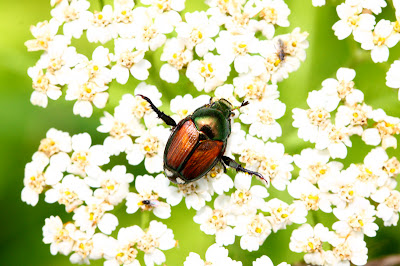However, some beetles are relatively simple to identify and can tell us a lot about the environment in which they live. Here are a few examples of beetles I have found recently:
 This first beetle belongs to one of the most well-recognized groups of beetles, although many people would not know it from a view like this, but rather from the bright yellow flashes it emits on warm summer nights. This beetle in the genus Photinus belongs to the family Lampyridae, the fireflies.
This first beetle belongs to one of the most well-recognized groups of beetles, although many people would not know it from a view like this, but rather from the bright yellow flashes it emits on warm summer nights. This beetle in the genus Photinus belongs to the family Lampyridae, the fireflies. This Strangalia famelica belongs to a group of beetles known as Lepturinae, the flower longhorns. Members of this subfamily often have skinny bodies, long antennae, and (as the name suggests) they are often associated with flowers. Species in this group of beetles become extremely common as summer flowers begin blooming. I found this particular beetle on the flower of a swamp rose (Rosa palustris).
This Strangalia famelica belongs to a group of beetles known as Lepturinae, the flower longhorns. Members of this subfamily often have skinny bodies, long antennae, and (as the name suggests) they are often associated with flowers. Species in this group of beetles become extremely common as summer flowers begin blooming. I found this particular beetle on the flower of a swamp rose (Rosa palustris).  This guy is another flower longhorn. I found this Strangalepta abbreviata on a wild hydrangea (Hydrangea arborescens) that was filled with various beetles, bees, flies, and wasps.
This guy is another flower longhorn. I found this Strangalepta abbreviata on a wild hydrangea (Hydrangea arborescens) that was filled with various beetles, bees, flies, and wasps. This fuzzy beetle of the genus Trichiotinus is commonly found on flowers. Every year, I begin seeing these when the wild hydrangea starts blooming. In fact, I found this individual on a flower head of a wild hydrangea. It is thought that the appearance and flight of this genus mimic that of bees in the genus Bombus.
This fuzzy beetle of the genus Trichiotinus is commonly found on flowers. Every year, I begin seeing these when the wild hydrangea starts blooming. In fact, I found this individual on a flower head of a wild hydrangea. It is thought that the appearance and flight of this genus mimic that of bees in the genus Bombus. The Elderberry Borer (Desmocerus palliatus) is an uncommon beetle that is often found near (or in this case, on) its hostplant, American elder (Sambucus canadensis). Like the Strangalia and Strangalepta beetles, this beetle is another flower longhorn, but is much larger than those species.
The Elderberry Borer (Desmocerus palliatus) is an uncommon beetle that is often found near (or in this case, on) its hostplant, American elder (Sambucus canadensis). Like the Strangalia and Strangalepta beetles, this beetle is another flower longhorn, but is much larger than those species. Any avid gardener in the eastern half of the United States will immediately recognize this pest beetle as Popillia japonica, the invasive Japanese Beetle. This scarab beetle causes severe damage as it eats the leaves of anything it can find. The Japanese beetle is a true generalist, so it will eat the leaves, flowers, and fruits of many shrubs and perennials (native and non-native), but it seems to particularily enjoy plants in the rose family.
Any avid gardener in the eastern half of the United States will immediately recognize this pest beetle as Popillia japonica, the invasive Japanese Beetle. This scarab beetle causes severe damage as it eats the leaves of anything it can find. The Japanese beetle is a true generalist, so it will eat the leaves, flowers, and fruits of many shrubs and perennials (native and non-native), but it seems to particularily enjoy plants in the rose family. This gorgeous, metallic beetle is often confused with the previous species, but is shinier and more colorful. Unlike the Japanese Beetle, the Dogbane Beetle (Chrysochus auratus) is a native species that is found on plants in the dogbane family. I found this one on indian-hemp (Apocynum cannabinum) accompanied by a little syrphid fly (Toxomerus marginatus).
This gorgeous, metallic beetle is often confused with the previous species, but is shinier and more colorful. Unlike the Japanese Beetle, the Dogbane Beetle (Chrysochus auratus) is a native species that is found on plants in the dogbane family. I found this one on indian-hemp (Apocynum cannabinum) accompanied by a little syrphid fly (Toxomerus marginatus).

2 comments:
Thanks for doing such a great blog, Corey. I'm wondering what kind of camera you use, and what your favorite insect id guides are?
Thanks! My camera is a Canon 40D, and for many of these insect photos, I use a 100mm macro lens. A great identification resource is bugguide.net, an incredible website for identification of insects of North America
Post a Comment